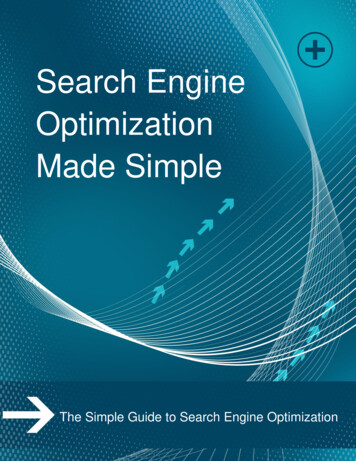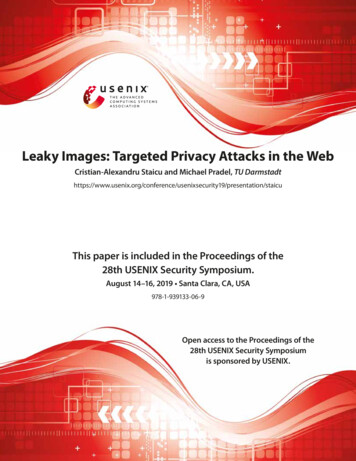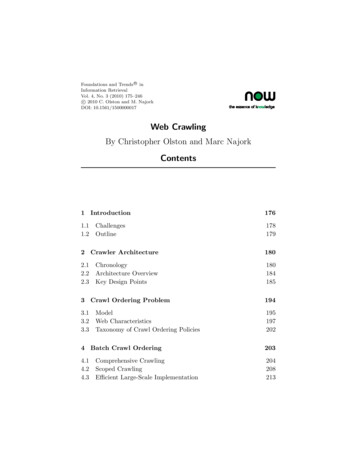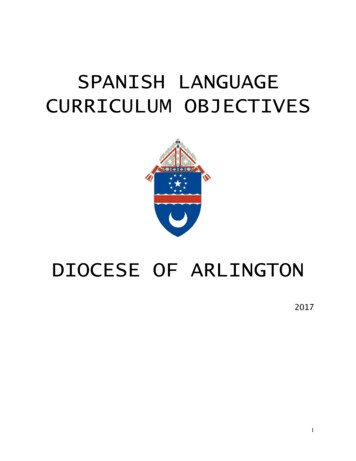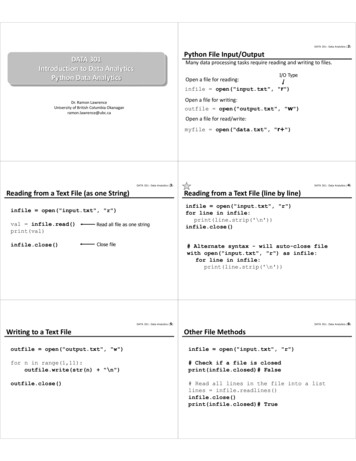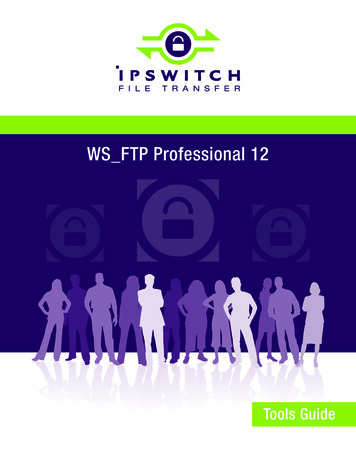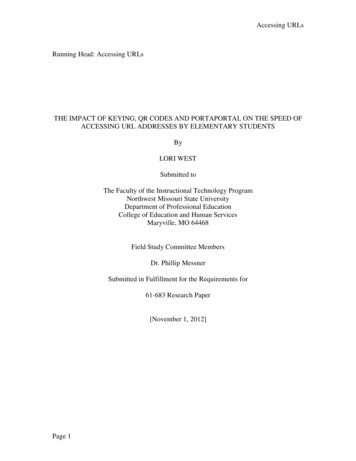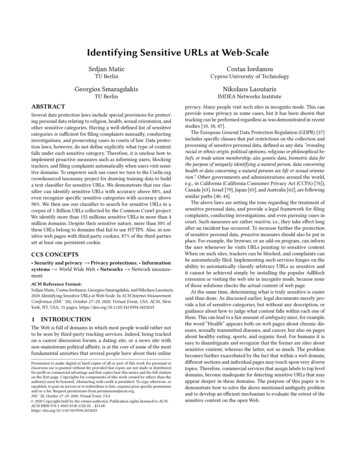
Transcription
Identifying Sensitive URLs at Web-ScaleSrdjan MaticCostas IordanouTU BerlinCyprus University of TechnologyGeorgios SmaragdakisNikolaos LaoutarisTU BerlinIMDEA Networks InstituteABSTRACTSeveral data protection laws include special provisions for protecting personal data relating to religion, health, sexual orientation, andother sensitive categories. Having a well-defined list of sensitivecategories is sufficient for filing complaints manually, conductinginvestigations, and prosecuting cases in courts of law. Data protection laws, however, do not define explicitly what type of contentfalls under each sensitive category. Therefore, it is unclear how toimplement proactive measures such as informing users, blockingtrackers, and filing complaints automatically when users visit sensitive domains. To empower such use cases we turn to the Curlie.orgcrowdsourced taxonomy project for drawing training data to builda text classifier for sensitive URLs. We demonstrate that our classifier can identify sensitive URLs with accuracy above 88%, andeven recognize specific sensitive categories with accuracy above90%. We then use our classifier to search for sensitive URLs in acorpus of 1 Billion URLs collected by the Common Crawl project.We identify more than 155 millions sensitive URLs in more than 4million domains. Despite their sensitive nature, more than 30% ofthese URLs belong to domains that fail to use HTTPS. Also, in sensitive web pages with third-party cookies, 87% of the third-partiesset at least one persistent cookie.CCS CONCEPTS Security and privacy Privacy protections; Informationsystems World Wide Web; Networks Network measurement.ACM Reference Format:Srdjan Matic, Costas Iordanou, Georgios Smaragdakis, and Nikolaos Laoutaris.2020. Identifying Sensitive URLs at Web-Scale. In ACM Internet MeasurementConference (IMC ’20), October 27–29, 2020, Virtual Event, USA. ACM, NewYork, NY, USA, 15 pages. ONThe Web is full of domains in which most people would rather notto be seen by third-party tracking services. Indeed, being trackedon a cancer discussion forum, a dating site, or a news site withnon-mainstream political affinity, is at the core of some of the mostfundamental anxieties that several people have about their onlinePermission to make digital or hard copies of all or part of this work for personal orclassroom use is granted without fee provided that copies are not made or distributedfor profit or commercial advantage and that copies bear this notice and the full citationon the first page. Copyrights for components of this work owned by others than theauthor(s) must be honored. Abstracting with credit is permitted. To copy otherwise, orrepublish, to post on servers or to redistribute to lists, requires prior specific permissionand/or a fee. Request permissions from permissions@acm.org.IMC ’20, October 27–29, 2020, Virtual Event, USA 2020 Copyright held by the owner/author(s). Publication rights licensed to ACM.ACM ISBN 978-1-4503-8138-3/20/10. . . y. Many people visit such sites in incognito mode. This canprovide some privacy in some cases, but it has been shown thattracking can be performed regardless as was demonstrated in recentstudies [10, 38, 87].The European General Data Protection Regulation (GDPR) [37]includes specific clauses that put restrictions on the collection andprocessing of sensitive personal data, defined as any data “revealingracial or ethnic origin, political opinions, religious or philosophical beliefs, or trade union membership, also genetic data, biometric data forthe purpose of uniquely identifying a natural person, data concerninghealth or data concerning a natural persons sex life or sexual orientation”. Other governments and administrations around the world,e.g., in California (California Consumer Privacy Act (CCPA) [76]),Canada [63], Israel [79], Japan [65], and Australia [62], are followingsimilar paths [40, 44].The above laws are setting the tone regarding the treatment ofsensitive personal data, and provide a legal framework for filingcomplaints, conducting investigations, and even pursuing cases incourt. Such measures are rather reactive, i.e., they take effect longafter an incident has occurred. To increase further the protectionof sensitive personal data, proactive measures should also be put inplace. For example, the browser, or an add-on program, can informthe user whenever he visits URLs pointing to sensitive content.When on such sites, trackers can be blocked, and complaints canbe automatically filed. Implementing such services hinges on theability to automatically classify arbitrary URLs as sensitive andit cannot be achieved simply by installing the popular AdBlockextension or visiting the web site in incognito mode, because noneof those solutions checks the actual content of web page.At the same time, determining what is truly sensitive is easiersaid than done. As discussed earlier, legal documents merely provide a list of sensitive categories, but without any description, orguidance about how to judge what content falls within each one ofthem. This can lead to a fair amount of ambiguity since, for example,the word “Health” appears both on web pages about chronic diseases, sexually transmitted diseases, and cancer, but also on pagesabout healthy eating, sports, and organic food. For humans it iseasy to disambiguate and recognize that the former are sites aboutsensitive content, whereas the latter, not so much. The problembecomes further exacerbated by the fact that within a web domain,different sections and individual pages may touch upon very diversetopics. Therefore, commercial services that assign labels to top leveldomains, become inadequate for detecting sensitive URLs that mayappear deeper in these domains. The purpose of this paper is todemonstrate how to solve the above mentioned ambiguity problemand to develop an efficient mechanism to evaluate the extent of thesensitive content on the open Web.
IMC ’20, October 27–29, 2020, Virtual Event, USAOur contributions: As with all classification tasks, to train a classifier for sensitive personal data, one needs a high quality trainingset with both sensitive and non sensitive pages. Our first majorcontribution is the development of a semi-automated methodologyfor compiling such a training set by filtering the Curlie [30] crowdsourced web taxonomy project. We develop a novel and scalabletechnique that uses category labels and the hierarchical structureof Curlie to address the core ambiguity challenge. Our carefullyselected training set comprises 156k sensitive URLs. To the best ofour knowledge this is the largest dataset of its type1 .We then consider different classification algorithms and performelaborate feature engineering to design a series of classifiers fordetecting sensitive URLs. We examine both meta-data driven classifiers that use only the URL, title, and meta description of a page,as well as classifiers that use the text of web pages. We apply ourclassifier on the largest publicly available snapshot of the (Englishspeaking) Web and estimate, for the first time, the percentage ofdomains and URLs involving sensitive personal data. Finally, welook within the identified sensitive web pages and report our preliminary observations regarding the privacy risks of people visitingthese pages.Our findings: We show that classifying URLs as sensitive based on the categoriesand content of their corresponding top-level domain is inaccurate.This means that popular domain classifications services such asAlexa and SimilarWeb may either fail to identify sensitive URLsbelow non-sensitive top level domains, or mis-classify as sensitive,non-sensitive URLs below a seemingly sensitive top level domain.This should not come as a surprise, given that such services areeither general purpose, or are optimized for other tasks that havenothing to do with classifying sensitive content. In essence, DNSbased blocking/domain blacklisting of sensitive content becomesineffective at the URL level. On the positive side, we show that Bayesian classifiers based onword frequency can detect sensitive URLs with an accuracy of atleast 88%. However, meta-data based classification, and text-basedclassification with do not seem to perform well. Also, word embedding techniques such as Word2Vec and Doc2Vec yield marginalbenefits for our classification task. When it comes to detecting specific sensitive categories, such asthose defined by GDPR: Health, Politics, Religion, Sexual Orientation, Ethnicity, our classifier achieves a high classification accuracyas well. For specific categories, such as Health (98%), Politics (92%),Religion (97%), our classifier achieves an accuracy that exceeds thebasic classification accuracy between sensitive and non-sensitiveURLs (88%). Applying our classifier on a Common Crawl snapshot of theEnglish speaking Web (around 1 Billion URLs), we identify 155million sensitive URLs in more than 4 million domains. Health,Religion, and Political Beliefs are the most popular categories witharound 70 millions, 35 millions, and 32 millions URLs respectively. Looking among the identified sensitive URLs we reach the conclusion that sensitive URLs are handled as any other URL, without any1 Forthe benefit of other research efforts in the field, at the following URL we makepublicly available our classifier and the categories we used to train it:https://bitbucket.org/srdjanmatic/sensitive web/Matic et al.special provision for the privacy of users. For example, we showthat 30% of sensitive URLs are hosted in domains that fail to useHTTPS. Also, in sensitive web pages with third-party cookies, 87%of the third-parties sets at least one persistent cookie.2EXTRACTING TRAINING DATA FROM AHUMAN-LABELED WEB TAXONOMYThe starting point for the creation of any classifier is a solid trainingset. This is a compelling requirement to understand the extentof the content related to sensitive personal data on the Web. Insuch case, the training set should be of high quality, well assortedand large to allow the classifier to deal with a wide range of webpages. Unfortunately, to the best of our knowledge, such a datasetis not readily available. In this section we explain how we builtthe training set for our classifier using hundreds of thousands ofcarefully selected URLs.2.1Limitations of Existing CommercialTaxonomy ServicesPrevious work relied on security solutions from vendors such asMcAfee [53] and Symantec [78] to categorize URLs [8, 73, 75]. Mostof these services are focused on fighting malware, and, therefore,their taxonomy includes a limited number of generic labels whichcategorize Effective Second Level Domains (ESLDs). Alexa [11]and SimilarWeb [74] are other extremely popular, but non securityoriented, solutions that characterize web sites at the domain level.An inherent limitation of all those approaches is that the servicecannot accurately categorize subdomains that are used for different purposes than the original ESLD. In particular scenarios thismight not be an issue, especially if a web site is homogeneous interms of content, or when the objective is to characterize just thedomain [69]. An example are web sites labeled as pornographywhere the majority of web pages actually contains pornographicmaterial [45].On the contrary, when the objective is to characterize individualweb pages, all of the above services start having problems. Thisis especially true for web sites such as news portals and bloggingservices, that include diverse and non-homogeneous content. Limitations are further exacerbated when the categories of interest aresensitive ones. In such cases commercial services have low coverageand, even when they do, they still suffer from the ambiguity problem mentioned earlier. For example, in the Alexa top domains forHealth, we find the US National Institute of health and UN WorldHealth Organization in the top two positions. Looking at top-20entries, we find also several fitness related web sites in the list. Being tracked while visiting such domains is probably less worrisomethan when the domain relates to cancer or HIV treatment.In addition to the coverage and ambiguity, another possiblesource of problems are the labels that services use. On one sidethose labels could be few and generic, without the ability to provideadditional details (e.g., sub-categories). On the other, commercialservices typically lack transparency in terms of how they assignlabels to domains. Even in scenarios where such issues are not a limitation, oftentimes commercial services offer expensive APIs whichare made available only to a small and targeted elite. This translatesin an audience which is composed exclusively of advertisers that
Identifying Sensitive URLs at Web-ScaleThe WebCurlieCrowd-sourcing1,525,865 URLs344,227 categoriesAutomated5,100 keywordsManual301 sensitivekeywordsAutomated Manual48,042 categoriesAutomated265,588 URLsClassificationCommon CrawlThe Sensitive WebFigure 1: From Web to Sensitive Web. Mixing and matchingcrowd-sourcing with automated and manual filtering to create the largest ever training set for sensitive content classifiers.want to make sure their ads are placed in appropriate contexts [2]or to proprietary solutions that work only when content is servedthrough a specific platform [3].2.2The Curlie DatasetTo overcome the limitations described above, we choose to build ourtraining set by selecting sensitive URLs from Curlie [30], the largestpublicly available taxonomy of web pages. In the following sectionswe provide details about Curlie, its content and our methodologyfor distinguishing sensitive from non-sensitive web pages. Figure 1illustrates how we blend crowd-sourcing (done by Curlie) withautomated and a manual steps (done by us) on the “thin-waist” ofan overall methodology that can identify the sensitive part of theWeb (Section. 4). The manual step at the “thin-waist” of the overallprocess needs to be performed only once to identify (un-ambiguous)GDPR-sensitive categories that can then be used repeatedly to drawfrom the Curlie truly sensitive URLs.What is it? Curlie is an open source project and the successor ofDMOZ, a community-based effort to categorize popular web pagesacross the Internet [88]. Thanks to the collaboration of 92,000 editors that manually evaluate and organize web pages [29], Curlierepresents one of largest human-edited directories of the Web. Editors join Curlie by applying to edit a category that corresponds totheir interests, and each editor is responsible for reviewing submissions to the categories she is in charge. New editors are initiallyallowed to edit only a few categories, but once they have accumulated a sufficient number of edits they are allowed to edit additionalareas. Community senior editors are responsible for evaluatingnew editors’ applications in a transparent process that assures highquality labeling of URLs [29]. Curlie contains 3.3 millions annotatedweb pages, that cover 1 million different categories organized asa hierarchical ontology. At the top of the hierarchy there are the15 top-categories visible at https://curlie.org, with the addition of a16th, not listed, Adult category. Each one of the top-categories isIMC ’20, October 27–29, 2020, Virtual Event, USAfurther divided into sub-categories that provide additional granularity up to maximum depth of 14 nested layers.Why we chose it? We chose Curlie for several reasons. First, unlikeAlexa and SimilarWeb, it categorizes full URLs instead of just ESLDs.Second, the number of its categories is several orders of magnitudegreater than those used by analogous commercial solutions [31, 91].Third, the organization of the dataset in a hierarchical ontologyallows us to efficiently navigate through the category tree andextract all the URLs that belong to a particular category. Finally,access to Curlie is free and not subject to any rate limitation.Data collection. In March 2017 Curlie stopped redistributing weeklyRDF2 dumps, and, therefore, we created a crawler to downloadthe most recent information [27, 28, 84]. We focus only on Englishcontent and thus, our crawler is seeded with the paths of the topcategories visible at https://curlie.org/en. For each seed path, thecrawler performs a depth-first search to collect all the URLs includedunder that particular branch. It is common that a sub-categorycontains links to another sub-category on a completely differentbranch, and the crawler keeps track of all the processed categoriesto avoid entering loops. After completing the crawling, we collected1,525,865 URLs that belong to 344,227 categories.Characterizing the collected data. By inspecting how the URLs arespread across the top-categories, we notice that half of the collectedURL belongs to Regional. This is a meta-category that acts as aggregator and groups other top-categories while providing informationat the regional or country level. The remaining 15 top-categories arerelatively balanced, with an average of 58,600 URLs per category.The only exceptions are Adult and News that contain less than10,000 elements each. Such layout confirms that Curlie editors havea wide range of interests, and that the collected dataset containsenough variety for building a well assorted training set.Next, we investigate the dataset coverage in terms of differentweb sites from which the URLs are sampled. We characterize websites through their Fully Qualified Domain Name (FQDN), andacross the entire dataset we observe 1,137,997 unique FQDNs. Onaverage, each FQDN is represented by 1.3 URLs, but this distributionis extremely skewed and only 4% of FQDNs have two or more URLs.This small set of web sites contributes with 431,707 URLs, whichcorresponds to approximately one third of the entire dataset. This isa potential problem, because if we train the classifier with contentobtained from a limited number of web sites, we run the risk ofending up with an over-fitted classifier that will not generalizewell to unknown domains. To test if our dataset contains enoughvariety, we manually inspect the top-100 FQDNs in terms of overallnumber of URLs associated to them. Collectively, such web sitesaccount for 10.4% of all the Curlie URLs, and each one of the top-32contributors has more than 1,000 unique URLs. In Table 1 we includethe top-10 FQDNs. The values in the second column show that thoseFQDNs are associated to thousands of categories, which in turncover the vast majority of Curlie top-categories (third column). Inthe last column we point out services that allow users to participatein the creation of new content. Common examples are serviceswhere users can build their own web site (e.g., www.angelfire.com2 RDFor Resource Description Framework is a family of World Wide Web Consortium specifications for conceptual description or modeling of information that isimplemented in web resources, e.g. URLs.
IMC ’20, October 27–29, 2020, Virtual Event, USAMatic et al.Table 1: Top-10 FQDNs contributing with the largest number of URLs. For each domain we report the total numberof categories and top-categories associated to it. A in thelast column indicates that multiple users are allowed to contribute with the creation of new k.comtools.ietf.org# URLs# Cat.# 3,9182,83399161569214164154Multi-user Table 2: Unique categories and top-categories associated toFQDNs and ESLDs with two or more URLs.# Categories12345 Cat.FQDNs 3479,375Top-Cats.FQDNs ,2591,610and members.tripod.com) or they are encouraged to contribute byadding comments and documents on a particular topic (e.g., www.imdb.com and tools.ietf.org). A third dominant category which isnot visible in Table 1, are news websites that account for 20% of thetop-100 FQDNs. In such case, the content creators are the numerousjournalists and editors. In general, those three types of service areextremely popular and 84% of the top-100 FQDNs belongs to oneof them. The remaining 16 FQDNs are specialized services offeringinformation on aviation, plants and hotels. After isolating the URLsassociated with these 16 FQDNs, we observe that they account onlyfor 1.4% of the dataset, and thus their impact on the training setcan only be marginal.As final assessment we study the differences among per-URL andper-domain categorization. Our goal is to understand the possiblebenefits of having categories assigned to individual URLs insteadof using a the same category for all the elements under an ESLD.To this end, for all the FQDNs associated to two or more URLs, weextract the corresponding ESLDs as well as the overall number ofcategories assigned to those domains. The results of this processare shown in Table 2. When we use full category names only 5% ofall the URLs under a particular FQDNs or ESLDs belong to the samecategory. This is somehow expected since Curlie has more than340,000 extremely fine-grained categories. These values changesignificantly if we adopt a more coarse-grained grouping, usingthe top-categories; in this case 42% of the URLs under a particulardomain belong to the same category. Despite having only 16 topcategories, and even if they include extremely generic types suchas Society or Regional, still 18% of the domains are flagged withat least three different top-category names. Those results suggestthat any commercial solution that uses a unique category for allthe URLs under the same ESLD, in 58% of the cases would erroneously categorize at least one of the URLs. Our analysis on Curliedemonstrates that the collected dataset (i) contains enough varietyfor building a well-assorted training set, and (ii) offers significantadvantages compared to commercial solutions. In the next sectionwe explain how we leverage this dataset to create the training setfor our classifier.2.3Building the Classifier Training SetUsing the Article 9 of GDPR we define five sensitive categoriesthat include Ethnicity, Health, Political Beliefs, Religion and SexualOrientation. According to GDPR, the collection and processing ofinformation about any of these categories should be subjected tospecial rules [36]. Our goal is to create a classifier that can identifyweb pages that belong to those five sensitive categories. To thisend, we first identify the Curlie categories that are related to the 5sensitive categories under GDPR, and then we collect the resultingURLs from Curlie. Finally, we download the content associated tothose URLs and use it as training set for our classifier.Identifying sensitive categories. Curlie contains hundreds of thousands of categories and, thus, we cannot simply inspect them manually to determine which ones meet the requirements for beingconsidered sensitive. We cannot leverage the organization of categories into a hierarchy, because we do not know the maximumdepth at which to stop the exploration without missing elementscontained in deeper branches (e.g., the category o might seem not relevant to health without knowing that it contains a sub-branch calledAddictions). Finally, as we do not have a list of descriptive keywords associated to each category, we cannot either select URLsby looking in the web pages for those keywords. It is extremelychallenging to craft such a list because the keywords we mightchoose might not be representative for the Curlie dataset. For example, a lookup of the “LGBT” across the Curlie dataset, generatesa set of 240 URLs, while searching for the keyword “gay” selects3,873 URLs. By using our own list we incur in the risk of includingmany ambiguous keywords (e.g., “virus”) that characterize bothsensitive and non-sensitive content, or others that are too specific(e.g., “HIV”). In both cases the consequence of the inability to include enough elements for particular categories, would result in asignificant loss in performance or even the impossibility to use theclassifier on other datasets.We develop a technique that extracts structured knowledge fromthe Curlie dataset, see Figure 1, and we use it to generate our training set. Our approach leverages the names that Curlie editors choosefor their categories to detect relevance with sensitive categories. Indetail, we first create a list of all the keywords included in the namesof the Curlie categories. Next, by selecting all the categories that contain a particular keyword, we associate a keyword to the list of URLsunder those categories. For example, let’s assume that the datasetcontains only three categories Health, Health/Addictions/Foodand Health/Animals/Food with respectively 3, 100 and 20 URLs.In such case, the list with the counting of the URLs associated toeach keyword would be: (Health, 123), (Addictions, 100), (Food,120), (Animals, 20).
Identifying Sensitive URLs at Web-Scale#Sensitive Categories:Ethnicity371-cat. 2-cat. 3-cat. 4-cat. 5-cat.20HealthIMC ’20, October 27–29, 2020, Virtual Event, USA81012107PoliticalBeliefs2014 9ReligionSexual9Orient.02012GDPR Cat.EthnicityPol. BeliefsSex. Orientation12767 1544 7Table 3: Content retrieved from the URLs of our training set,grouped into the GDPR sensitive categories.127912#URLs9,54715,6683,924GDPR ,92312406080# of keywords100120Figure 2: Sensitive categories and corresponding set of keywords. For each set of keywords, we report how many othersensitive categories might be associated to this same set.After applying this process on the entire Curlie dataset, we obtain a set of 110,475 unique keywords. Next, we manually inspectthose keywords to identify those that could be could be potentiallyassociated to sensitive categories. For this process we restrict thefocus on a subset of 5,1000 most representative keywords, whichare associated to at least 100 URLs. Moreover, we apply a greedyapproach and we include as many generic keywords as possible(e.g., “Health”) while discarding only those that are unlikely tobe associated with any sensitive content (e.g., “Animals”). At theend of this analysis, we generate a set of 301 carefully selectedkeywords which we annotate with all of the sensitive categoriesthat could be connected to them. Some keywords are extremelyspecific (e.g., “Judaism”), while others could be linked to multiplesensitive categories (e.g., “Communities”). In the final step, we manually inspect 48,042 the Curlie categories where the 301 keywordsappear, and we verify if they are indeed sensitive. When a Curliecategory is confirmed to be sensitive, all the URLs contained underthis category are added to the corresponding GDPR sensitive category. This is a slow and time-consuming activity, but is necessaryto ensure that all the URLs are included in the correct category.Furthermore, this manual step needs to be done only once, and wecan then re-draw URLs from Curlie with high confidence that theywill indeed be sensitive. For some elements we were able to assessthe sensitivity of the URLs by leveraging only the keyword thatappears in the category name (e.g., all the URLs under the 553 categories that embed the “Local Churches” keyword). In other cases,we inspected the structure of the Curlie categories together withthe location of the keyword. For example, of the 13,299 categoriesthat include the “Health” keyword, 4,927 were under the “Regional”top-category and “Health” always appeared as final sub-category(e.g., Regional/Asia/India/Punjab/Health). After checking afew dozen samples, in all those cases the URLs were pointing tolocal services or clinics and we label all the URLs under those 4,927categories as health-related. To facilitate the analysis, we use severaltricks including: sorting alphabetically the categories, leveragingthe information from sub-categories, checking URLs strings andweb page content. As side effect of the manual validation, all theURLs in categories that are not sensitive are included into a sixthNon-sensitive category.Figure 2 shows how representative the 301 keywords are for eachsensitive category. With respect to the specificity of the keywords,we notice that in general 249 of the keywords (the red boxes inthe figure) are unambiguous and they uniquely identify only onecategory. This is the case of “Local Churches” or “Marxism”, whichimmediately recall to the sensitive categories “Religion” and “Political Beliefs”. Generic terms such as “Clubs and Associations” or“Organizations”, that can be related to several sensitive categories,appear to be rare and account only for 4% of all the keywords. Notall of the sensitive categories have an equal number of keywordsand some categories are less represented. Moreover, categories suchas Ethnicity, Political Beliefs and Sexual Orientation also containhigher percentage of generic keywords which can be associated tomultiple sensitive categories (the non-red boxes in Figure 2). A direct consequence is that these sensitive categories are less likely togenerate many candidates for the corresponding Curlie categories.At the end of the validation process, we are left with 265,558 URLs,each one tagged with at least one GDPR-sensitive category, drawnfrom 48,042 Curlie categories.2.4Final Labeled DatasetAfter successfully mapping the GDPR sensitive categories on theCurlie dataset, we use the labeled URLs to download the contentto train our classifier. As first step, we filter out all the URLs thatreceived more than one sensitive category as label. Since thosemulti-category URLs will not be used to create the training set wecan avoid download the corresponding content. Next, we connectto each URL from four differen
as well as classifiers that use the text of web pages. We apply our classifier on the largest publicly available snapshot of the (English speaking) Web and estimate, for the first time, the percentage of domains and URLs involving sensitive personal data. Finally, we look within the identified sensitive web pages and report our pre-


